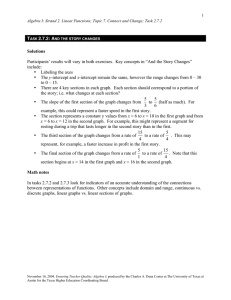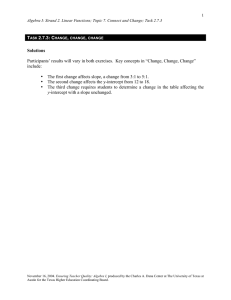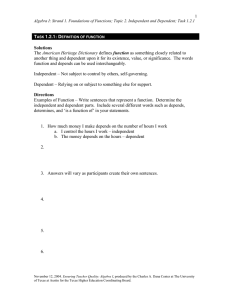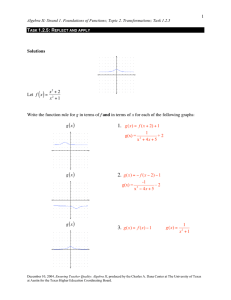1 y = x . Consider the following:
advertisement
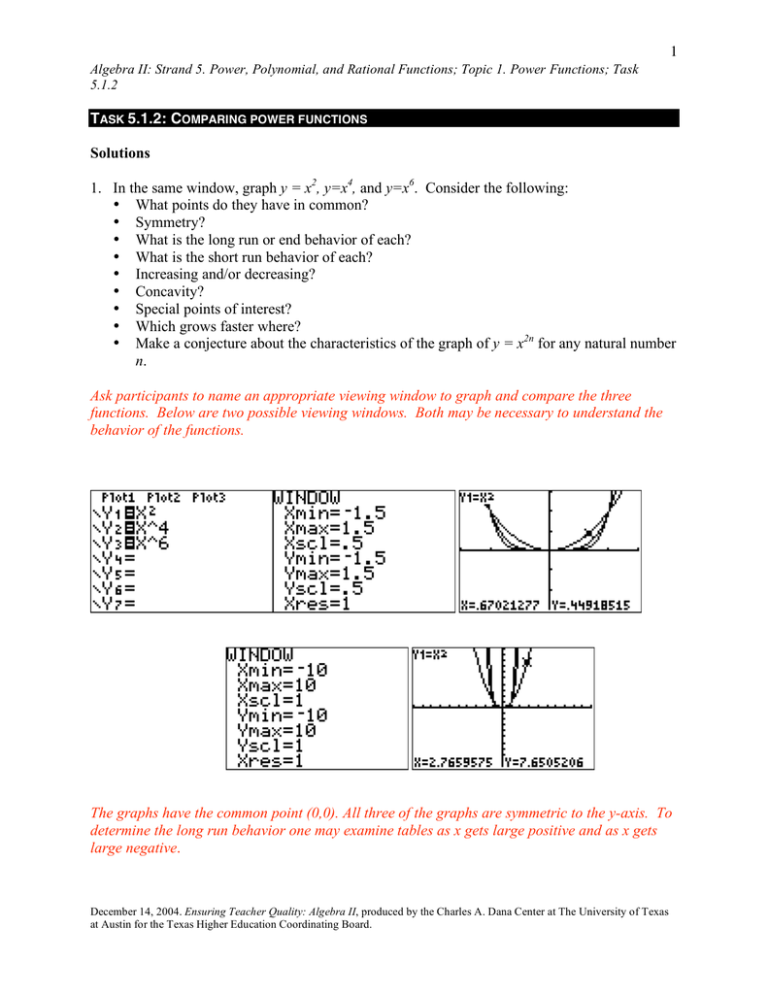
1 Algebra II: Strand 5. Power, Polynomial, and Rational Functions; Topic 1. Power Functions; Task 5.1.2 TASK 5.1.2: COMPARING POWER FUNCTIONS Solutions 1. In the same window, graph y = x2, y=x4, and y=x6. Consider the following: • What points do they have in common? • Symmetry? • What is the long run or end behavior of each? • What is the short run behavior of each? • Increasing and/or decreasing? • Concavity? • Special points of interest? • Which grows faster where? • Make a conjecture about the characteristics of the graph of y = x2n for any natural number n. Ask participants to name an appropriate viewing window to graph and compare the three functions. Below are two possible viewing windows. Both may be necessary to understand the behavior of the functions. The graphs have the common point (0,0). All three of the graphs are symmetric to the y-axis. To determine the long run behavior one may examine tables as x gets large positive and as x gets large negative. December 14, 2004. Ensuring Teacher Quality: Algebra II, produced by the Charles A. Dana Center at The University of Texas at Austin for the Texas Higher Education Coordinating Board. 2 Algebra II: Strand 5. Power, Polynomial, and Rational Functions; Topic 1. Power Functions; Task 5.1.2 As x ! +" and as x ! "# the values for all three functions are increasing without bound, but y=x6 grows large faster than the quartic function which in turn grows large faster than the square function. To consider the short run behavior zoom in on the point (0,0). The graphs for all three functions appeared flat in the original viewing window, but these windows show that for values near 0, it is evident that y = x 6 is “flattest”, followed by y=x4. All three graphs are always concave up. The point (0,0) is a vertex for the graphs. The graph of any even power function will contain the point (0,0), be symmetric about the y-axis, be concave up, and will have tails reaching to positive infinity in both directions (end behavior). 2. In the same window, graph y = x, y=x3, and y=x5. Consider the following: • What points do they have in common? • Symmetry? • What is the long run or end behavior of each? • What is the short run behavior of each? December 14, 2004. Ensuring Teacher Quality: Algebra II, produced by the Charles A. Dana Center at The University of Texas at Austin for the Texas Higher Education Coordinating Board. 3 Algebra II: Strand 5. Power, Polynomial, and Rational Functions; Topic 1. Power Functions; Task 5.1.2 • • • • • Increasing and/or decreasing? Concavity? Special points of interest? Which grows faster where? Make a conjecture about the characteristics of the graph of y = x2n+1 for any natural number n. Ask participants to name an appropriate viewing window to graph and compare the three functions. The graphs have the common point (0,0). The graphs are all symmetric to the origin. Long run behavior: As x ! +" the values for all functions are increasing without bound, but the quintic functions’ values are largest. All the functions grow rapidly, but the larger the power, the faster the function grows, in the long run. As x ! "# , all three functions decrease without bound, with the quintic function decreasing fastest. To consider the short run behavior zoom in on the point (0,0). The graph of y = x is a line, and not too interesting. The graphs for both y = x3 and y = x5 appeared flat in the original viewing window, but these windows show that for values near 0, it is evident that both graphs change shape, from being concave down to being concave up. For both y = x3 and y = x5, the point (0,0) is called a point of inflection, a point where the curve changes its concavity. At this point, the presenter may assign all of the remaining exercises to be worked in groups or assign each group one of the problems 3 – 8. After these problems have been discussed as a whole group, assign exercise 9 to be discussed in groups. !1 3. • • • • • • !2 Compare the graphs of y = x and y = x . Consider the following: Discontinuities, asymptotes? Symmetry? What is the long run or end behavior of each? What is the short run behavior of each? Increasing and/or decreasing? Concavity? December 14, 2004. Ensuring Teacher Quality: Algebra II, produced by the Charles A. Dana Center at The University of Texas at Austin for the Texas Higher Education Coordinating Board. 4 Algebra II: Strand 5. Power, Polynomial, and Rational Functions; Topic 1. Power Functions; Task 5.1.2 • • Special points of interest? Which grows faster where? y = x !1 y = x !2 Tables may be used to help answer some of the questions. Both functions are discontinuous at x = 0 and have a vertical asymptote at x = 0 . The function y = x !1 is symmetric to the line y = x, while y = x !2 is symmetric to the y-axis. There are no zeroes for these functions. As x becomes very large positive (and negative) both functions approach 0. However, y = x !2 approaches 0 faster than y = x !1 . As x becomes very small positive both functions approach +∞, but as x becomes very small negative, y = x-1 approaches -∞ and y = x-2 approaches +∞. y = x-1 is concave up and decreasing for positive values of x and concave down and decreasing for negative values of x . y = x !2 is concave up and decreasing for positive values of x and concave up and increasing for negative values of x . • Describe another power function that will be less than y = x !2 for large values of x. Any power function that has an integer exponent less than –2 will be smaller than y = x !2 for large values of x. 1 2 1 3 4. Compare the graphs of y = x and y = x . Consider the following: • • • • • • Symmetry? Domain? What is the long run or end behavior of each? Increasing and/or decreasing? Concavity? Special points of interest? December 14, 2004. Ensuring Teacher Quality: Algebra II, produced by the Charles A. Dana Center at The University of Texas at Austin for the Texas Higher Education Coordinating Board. 5 Algebra II: Strand 5. Power, Polynomial, and Rational Functions; Topic 1. Power Functions; Task 5.1.2 1 y = x( 2 ) 1 y = x( 3 ) 1 y = x ( 2 ) has no symmetry. 1 y = x ( 3 ) is symmetrical to the origin. 1 y = x ( 2 ) has a restricted domain of all real numbers greater than 0. 1 y = x ( 3 ) has a domain of all real numbers. 1 Both functions approach infinity as x gets large but the graph below shows that y = x ( 2 ) 1 grows larger faster than y = x ( 3 ) . • 2 How would the function y = x ( 5 ) be related to these two functions? The graph would be between these two functions for positive values of x, because the 2 1 1 exponent, , is between and . 5 3 2 1 3 2 4 1 2 3 5. Order from least to greatest for 0 ! x ! 1, y = x , y = x , y = x , y = x , y = x , y = x . Sketch the graphs. Functions from least to greatest value for 0 ! x < 1 . 1 1 y = x 4 , y = x 3 , y = x 2 , y = x , y = x( 2 ) , y = x( 3 ) December 14, 2004. Ensuring Teacher Quality: Algebra II, produced by the Charles A. Dana Center at The University of Texas at Austin for the Texas Higher Education Coordinating Board. 6 Algebra II: Strand 5. Power, Polynomial, and Rational Functions; Topic 1. Power Functions; Task 5.1.2 Graphs: Trace on the graphs to determine the order. • Describe the difference in the concavities of these functions in this window. The functions with exponent greater than 1 are concave up. The functions with exponent less than 1 are concave down. • Which of these functions contain the point (1, 1)? All power functions of the form y = x p contain the point (1, 1). 1 3 2 4 1 2 3 6. Order from least to greatest for x > 1, y = x , y = x , y = x , y = x , y = x , y = x . Sketch the graphs. Functions from least to greatest value for x > 1 . 1 1 y = x( 3 ) , y = x( 2 ) , y = x , y = x 2 , y = x 3 , y = x 4 • • Describe another way to compare these functions. Tables may be used to compare the function values. Which of these functions grows faster? The function y = x 4 grows faster. !2 !1 !3 7. Order from least to greatest for 0 ! x ! 0.5 , y = x , y = x , y = x , y = x . Sketch the graphs. Functions from least to greatest value for 0 ! x < 1 . y = x , y = x !1 , y = x !2 , y = x !3 December 14, 2004. Ensuring Teacher Quality: Algebra II, produced by the Charles A. Dana Center at The University of Texas at Austin for the Texas Higher Education Coordinating Board. 7 Algebra II: Strand 5. Power, Polynomial, and Rational Functions; Topic 1. Power Functions; Task 5.1.2 !2 !1 !3 8. Order from least to greatest for x > 0.5 , y = x , y = x , y = x , y = x . Sketch the graph. Functions from least to greatest value for x > 1 . y = x !3 , y = x !2 , y = x !1 , y = x • Describe the concavity. Each of these functions is concave up for x > 1 except y = x which is neither concave up nor concave down. 9. Match the functions to their graphs (see worksheet). The functions should be arranged by their exponents. In the interval from 0 to k, the greatest function is the one with the smallest exponent. a. 3 b. 1 c. 2 d. 4 Math notes One might explain concavity by asking the participants to imagine a line which is tangent to a curve. If the curve is above the line, the curve is concave up at the point of tangency. If the curve is below the line, the curve is concave down at the point of tangency. This may be illustrated by graphing these two situations: December 14, 2004. Ensuring Teacher Quality: Algebra II, produced by the Charles A. Dana Center at The University of Texas at Austin for the Texas Higher Education Coordinating Board. 8 Algebra II: Strand 5. Power, Polynomial, and Rational Functions; Topic 1. Power Functions; Task 5.1.2 TASK 5.1.2: COMPARING POWER FUNCTIONS p If k and p are any constants, then y = kx is a power function of x. Since the parameter k provides a vertical stretch factor and/or a reflection across the x-axis (if k is negative), we will let k = 1 so that we can concentrate on the effect of the parameter p. 1. In the same window, graph y = x2, y=x4, and y=x6. Consider the following: • • • • • • • • • What points do they have in common? Symmetry? What is the long run or end behavior of each? What is the short run behavior of each? Increasing and/or decreasing? Concavity? Special points of interest? Which grows faster where? Make a conjecture about the characteristics of the graph of y = x2n for any natural number n. 2. In the same window, graph y = x, y=x3, and y=x5. Consider the following: • • • • • • • • • 3. What points do they have in common? Symmetry? What is the long run or end behavior of each? What is the short run behavior of each? Increasing and/or decreasing? Concavity? Special points of interest? Which grows faster where? Make a conjecture about the characteristics of the graph of y = x2n+1 for any natural number n. Compare the graphs of y = x • • • • • • • • !1 !2 and y = x . Consider the following: Discontinuities, asymptotes? Symmetry? What is the long run or end behavior of each? What is the short run behavior of each? Increasing and/or decreasing? Concavity? Special points of interest? Which grows faster where? December 14, 2004. Ensuring Teacher Quality: Algebra II, produced by the Charles A. Dana Center at The University of Texas at Austin for the Texas Higher Education Coordinating Board. 9 Algebra II: Strand 5. Power, Polynomial, and Rational Functions; Topic 1. Power Functions; Task 5.1.2 1 2 1 3 4. Compare the graphs of y = x and y = x . Consider the following: • • • • • • Symmetry? Domain? What is the long run or end behavior of each? Increasing and/or decreasing? Concavity? Special points of interest? Use graphs and tables to order the following: 1 3 2 1 2 4 3 5. Order from least to greatest for 0 ! x ! 1, y = x , y = x , y = x , y = x , y = x , y = x . Sketch the graphs. 1 3 2 1 2 4 3 6. Order from least to greatest for x > 1, y = x , y = x , y = x , y = x , y = x , y = x . Sketch the graphs. !2 !1 !3 7. Order from least to greatest for 0 < x ! 0.5 , y = x , y = x , y = x , y = x . Sketch the graphs. !2 !1 !3 8. Order from least to greatest for x > 0.5 , y = x , y = x , y = x , y = x . Sketch the graphs. December 14, 2004. Ensuring Teacher Quality: Algebra II, produced by the Charles A. Dana Center at The University of Texas at Austin for the Texas Higher Education Coordinating Board. 10 Algebra II: Strand 5. Power, Polynomial, and Rational Functions; Topic 1. Power Functions; Task 5.1.2 9. Match the functions to their graphs: ____ a. y = kx ____ b. y = kx ____ c. y = kx ____ d. y = kx 9 16 3 11 3 8 5 7 December 14, 2004. Ensuring Teacher Quality: Algebra II, produced by the Charles A. Dana Center at The University of Texas at Austin for the Texas Higher Education Coordinating Board.
